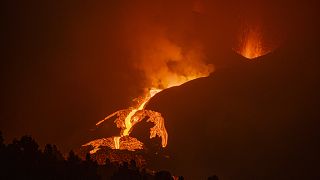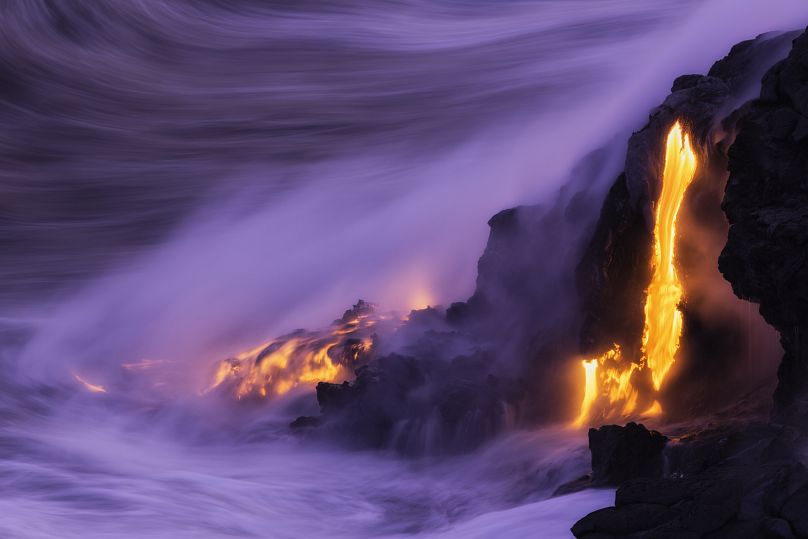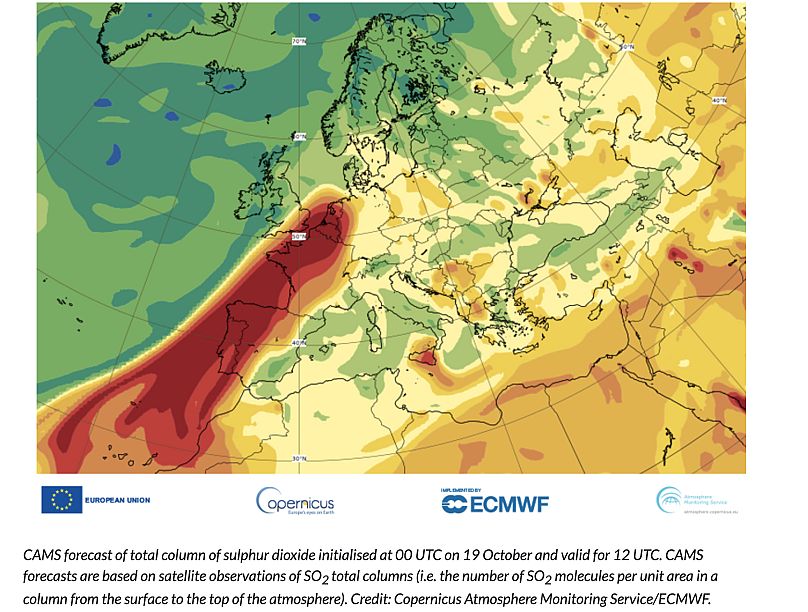
Volcanic Eruption on Spain's Canary Island of La Palma -
Copyright Getty Images
CLIMATE NOW Updated: 28/02/2022 -
Monitoring the interaction of volcanic eruptions with the atmosphere is increasingly important in a changing climate
It was around Christmas last year that the Cumbre Vieja volcano stopped spitting lava on the Spanish island of La Palma, bringing some relief to the locals after more than 85 days of eruption and €1 billion in damages. But in 2021 Cumbre Vieja was not the only volcano making headlines with its massive outburst. Across the world, from Kamceatka to Reunion and Guatemala, and from Iceland to Sicily, several volcanoes fired up into sizable eruptions, adding to the list of extreme events affecting lives and economies.
Increasingly, when extreme events occur, be they wildfires, typhoons, or floods, they stir discussions about the role of climate change in making natural hazards more frequent and/or intense. But is that the case for volcanic eruptions too? Can we tie volcano behaviour to climate change? And if so, why does it matter?
The climate connection
Volcanoes do interact with the climate through what they inject into the atmosphere during eruptions. Eruptions produce big amounts of gas, particles (known as aerosols), ash and metals, temporarily altering the climate at a local, regional, or even global scale.
“Large volcanic eruptions in the past have changed global climate directly and by reinforcing other processes,” says Dr. Santiago Arrellano, researcher at the Department of Space, Earth and Environment at the Chalmers Institute of Technology. An eruption’s effect on the climate depends on the location, altitude, amount, and composition of the material spewed, explains Dr. Arrellano. For example, tropical eruptions will have a bigger impact than those in upper latitudes, as air from the tropics travels more widely, and can carry volcanic emissions across the globe. Also, stronger eruptions have more enduring effects as they send particles into the stratosphere, where they remain for longer. In the Philippines, for example, Mount Pinatubo’s eruption in 1991 sent huge amounts of particles and gas more than 20 km high into the atmosphere, which then circled the planet for about three weeks.

© Getty Images Lava ocean entry, Kilauea, Hawaii
Although it could seem that explosions of steaming hot lava and gas would warm up the atmosphere, science points to the contrary. While eruptions do spit out global warming CO2 – although all of the Earth’s volcanoes erupting together would produce 100 times less carbon than human activities – they have a predominantly cooling influence on the climate. “The effect of large volcanic eruptions on our climate […] is due to the emission of particles, mostly fine ash and sulphates, which are very effective in scattering solar radiation,” says Dr. Arrellano. “These sulphate aerosol particles are very tiny and shiny and reflect some of the incoming sunlight back to space, which results in a temporary cooling effect at Earth’s surface,” says Dr. Anya Schmidt, Professor for Climate Modelling at LMU in Munich. “Averaged across the globe, the surface cooling effect is up to about 0.5°C for bigger eruptions such as the Mt. Pinatubo eruption and lasts for a few years,” says Dr. Schmidt.
The effects of more recent events remain to be seen. “We still need to see if the 2022 eruption in Tonga [...] will have a noticeable effect on the climate,” says Dr. Arrellano.
Eruptions and climate change
Recently, researchers are exploring how climate change could influence eruptions, by looking at how things might change at ground level, as well as up in the air.
Some studies point out that shifting patterns in the atmosphere’s circulation could alter the cooling effect of volcanic plumes. Research from Cambridge University and the Met Office shows that the impacts of a warmer climate on big versus smaller eruptions will differ. “For large eruptions such as Pinatubo’s, which generally occur once or twice per century, climate change will cause volcanic plumes to rise higher and aerosols to spread faster over the globe, amplifying the cooling by about 15 per cent compared to the present-day climate,” says Dr. Schmidt.
“But for smaller-sized eruptions such as the 2011 Nabro eruption in Eritrea, which typically happen yearly, the surface cooling effect will be reduced by about 75 per cent under a high-end warming scenario” (n.b.under multiple degrees of warming). As the tropopause, the layer between the lower atmosphere and the stratosphere, is predicted to increase, this means that volcanic plumes will take more time to reach the latter, Schmidt explains. As a consequence, the aerosols from eruptions will remain low in the air and will have limited impact, as they will be quickly washed out by precipitation.
Scientists are also looking at how climate change could influence how frequently volcanic eruptions occur. “There is an interesting connection here,” says Dr. Arrellano, “because global warming causes the melting of glaciers, many of which cover the flanks of active volcanoes.” According to Dr. Arrellano, a massive melting will reduce the pressure on the Earth’s surface, altering processes in its crust, causing for example hot magma to get in contact with aquifers. “This may in turn trigger volcanic activity, as the whole system is interconnected,” says Dr. Arrellano. However, more research is needed, as between 1850 and now, there is no evidence that eruptions have become more frequent with glacier melting, according to Dr. Schmidt.
Volcanoes at high elevation could also be affected by climate change if they have ice caps that are melting, says Dr. Tamsin Mather, professor of Earth Sciences at the University of Oxford. “If the ice caps maintain volcanic structures, their disappearance could lead to instability, and events such as volcanic landslides.”
Monitoring volcanic emissions
While the impacts of climate change on volcanoes remain difficult to gauge, monitoring emissions from eruptions is critical for air quality, public health, and industries such as aviation. The Copernicus Atmosphere Monitoring Service (CAMS) regularly tracks the transport and behaviour of sulphur dioxide from eruptions. In the case of the Cumbre Vieja volcano, CAMS monitored SO2 plumes travelling across North Africa, Europe and the Atlantic, all the way to the Caribbean region, where sulphate aerosols contributed to poor air quality conditions. CAMS has also monitored emissions resulting from recent eruptions of Mount Etna in Sicily, La Souffriere in St. Vincent, Nyiragongo in Congo, and Raikoke in the Kuril Islands.

The effects of more recent events remain to be seen. “We still need to see if the 2022 eruption in Tonga [...] will have a noticeable effect on the climate,” says Dr. Arrellano.
Eruptions and climate change
Recently, researchers are exploring how climate change could influence eruptions, by looking at how things might change at ground level, as well as up in the air.
Some studies point out that shifting patterns in the atmosphere’s circulation could alter the cooling effect of volcanic plumes. Research from Cambridge University and the Met Office shows that the impacts of a warmer climate on big versus smaller eruptions will differ. “For large eruptions such as Pinatubo’s, which generally occur once or twice per century, climate change will cause volcanic plumes to rise higher and aerosols to spread faster over the globe, amplifying the cooling by about 15 per cent compared to the present-day climate,” says Dr. Schmidt.
“But for smaller-sized eruptions such as the 2011 Nabro eruption in Eritrea, which typically happen yearly, the surface cooling effect will be reduced by about 75 per cent under a high-end warming scenario” (n.b.under multiple degrees of warming). As the tropopause, the layer between the lower atmosphere and the stratosphere, is predicted to increase, this means that volcanic plumes will take more time to reach the latter, Schmidt explains. As a consequence, the aerosols from eruptions will remain low in the air and will have limited impact, as they will be quickly washed out by precipitation.
Scientists are also looking at how climate change could influence how frequently volcanic eruptions occur. “There is an interesting connection here,” says Dr. Arrellano, “because global warming causes the melting of glaciers, many of which cover the flanks of active volcanoes.” According to Dr. Arrellano, a massive melting will reduce the pressure on the Earth’s surface, altering processes in its crust, causing for example hot magma to get in contact with aquifers. “This may in turn trigger volcanic activity, as the whole system is interconnected,” says Dr. Arrellano. However, more research is needed, as between 1850 and now, there is no evidence that eruptions have become more frequent with glacier melting, according to Dr. Schmidt.
Volcanoes at high elevation could also be affected by climate change if they have ice caps that are melting, says Dr. Tamsin Mather, professor of Earth Sciences at the University of Oxford. “If the ice caps maintain volcanic structures, their disappearance could lead to instability, and events such as volcanic landslides.”
Monitoring volcanic emissions
While the impacts of climate change on volcanoes remain difficult to gauge, monitoring emissions from eruptions is critical for air quality, public health, and industries such as aviation. The Copernicus Atmosphere Monitoring Service (CAMS) regularly tracks the transport and behaviour of sulphur dioxide from eruptions. In the case of the Cumbre Vieja volcano, CAMS monitored SO2 plumes travelling across North Africa, Europe and the Atlantic, all the way to the Caribbean region, where sulphate aerosols contributed to poor air quality conditions. CAMS has also monitored emissions resulting from recent eruptions of Mount Etna in Sicily, La Souffriere in St. Vincent, Nyiragongo in Congo, and Raikoke in the Kuril Islands.

© Copernicuseuronews
“There are multiple ways to monitor emission of lava, gases, ash, or aerosols emitted from volcanoes, but the accuracy depends on the property and the type of emission,” says Dr. Arrellano, who has been working with CAMS on providing information on volcanic emissions estimates. Remote sensing on the ground, in the air and in space can quantify gaseous SO2, satellites can map volcanic ash, while ground mapping and thermal radiation are used to track lava. “Most of these techniques used for monitoring volcanic emissions were not designed for this purpose,” says Dr. Arrellano. “They are by-products of missions with other objectives, such as global monitoring of the ozone layer.” The data is used widely. “Volcanologists want to track the rate and magnitude of emission of gases, lava or ashes to determine the physical state of the volcano and predict its activity. The meteorologist may be interested in tracking volcanic plumes to understand circulation patterns and the interaction of volcanoes with the atmosphere,” says Dr. Arrellano. “The climate scientist wants to know where, how high and how much of certain species is emitted to quantify the climate forcing. Air transport authorities are interested in observing the location of volcanic ash plumes to alert pilots and avoid accidents.”
Although CAMS does not monitor eruptions themselves, it offers information on the load of SO2 in the atmosphere through near real-time satellite observations and combines that data with its global forecasts to predict the composition and quality of the air over a five-day period.
Understanding how volcanoes and climate influence each other remains challenging, according to Dr. Schmidt. “While some of the feedback loops are becoming more obvious now, the climate system is complex and getting a grasp of all potential feedback loops is critical in our quest to make accurate climate projections that consider volcanic eruptions.”
Partner content presented by ‘Partner Content presented by’ is used to describe brand content that is paid for and controlled by the advertiser rather than the Euronews editorial team. This content is produced by commercial departments and does not involve Euronews editorial staff or news journalists. The funding partner has control of the topics, content and final approval in collaboration with Euronews’ commercial production department.
‘Partner Content presented by’ is used to describe brand content that is paid for and controlled by the advertiser rather than the Euronews editorial team. This content is produced by commercial departments and does not involve Euronews editorial staff or news journalists. The funding partner has control of the topics, content and final approval in collaboration with Euronews’ commercial production department.
“There are multiple ways to monitor emission of lava, gases, ash, or aerosols emitted from volcanoes, but the accuracy depends on the property and the type of emission,” says Dr. Arrellano, who has been working with CAMS on providing information on volcanic emissions estimates. Remote sensing on the ground, in the air and in space can quantify gaseous SO2, satellites can map volcanic ash, while ground mapping and thermal radiation are used to track lava. “Most of these techniques used for monitoring volcanic emissions were not designed for this purpose,” says Dr. Arrellano. “They are by-products of missions with other objectives, such as global monitoring of the ozone layer.” The data is used widely. “Volcanologists want to track the rate and magnitude of emission of gases, lava or ashes to determine the physical state of the volcano and predict its activity. The meteorologist may be interested in tracking volcanic plumes to understand circulation patterns and the interaction of volcanoes with the atmosphere,” says Dr. Arrellano. “The climate scientist wants to know where, how high and how much of certain species is emitted to quantify the climate forcing. Air transport authorities are interested in observing the location of volcanic ash plumes to alert pilots and avoid accidents.”
Although CAMS does not monitor eruptions themselves, it offers information on the load of SO2 in the atmosphere through near real-time satellite observations and combines that data with its global forecasts to predict the composition and quality of the air over a five-day period.
Understanding how volcanoes and climate influence each other remains challenging, according to Dr. Schmidt. “While some of the feedback loops are becoming more obvious now, the climate system is complex and getting a grasp of all potential feedback loops is critical in our quest to make accurate climate projections that consider volcanic eruptions.”
Partner content presented by
 ‘Partner Content presented by’ is used to describe brand content that is paid for and controlled by the advertiser rather than the Euronews editorial team. This content is produced by commercial departments and does not involve Euronews editorial staff or news journalists. The funding partner has control of the topics, content and final approval in collaboration with Euronews’ commercial production department.
‘Partner Content presented by’ is used to describe brand content that is paid for and controlled by the advertiser rather than the Euronews editorial team. This content is produced by commercial departments and does not involve Euronews editorial staff or news journalists. The funding partner has control of the topics, content and final approval in collaboration with Euronews’ commercial production department.
No comments:
Post a Comment